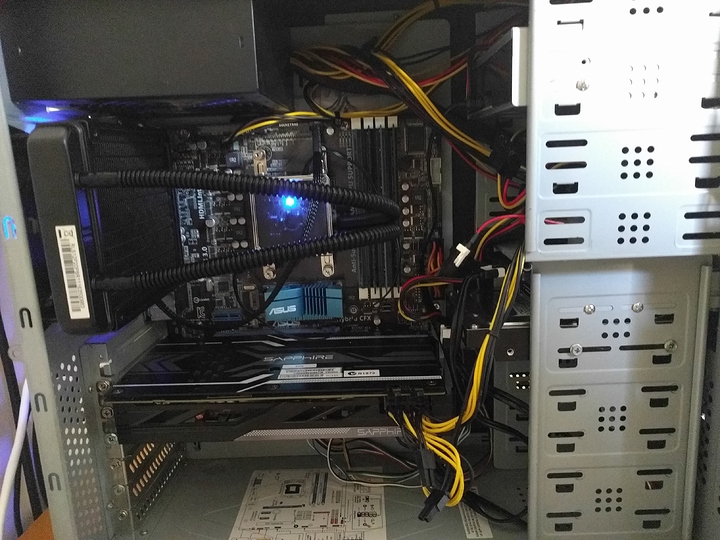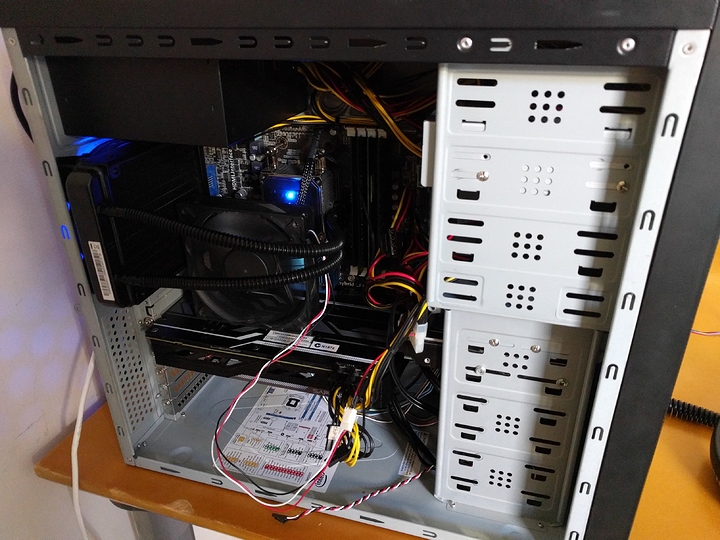So I recently upgraded from my AMD FX-4300 to the FX-8350 for cheap; I put it into my system and since I didn't have a 3rd party cooler, I slapped on the stock cooler. Worked fine apart from from sounding like a jet engine about to take off. I could finally play DOOM at 60+ FPS on ultra and CS:GO at an acceptable framerate!
Eventually, I got tired of being deafened every time I turned on my PC so I decided to upgrade to an actually good cooler. After browsing around my local PC part retailer for a bit, I decided to get the Hyper 212X, but it turned out the site hadn't been updated and they were actually out of stock, so I got the Coolermaster Seidon 120V, an entry level water cooler (Also, it's compatible with AM4, Cool!).
There were some issues with installation, It would only fit in one way which meant I couldn't put the side panel on:
That's not really relevant, I just wanted to share my pain...
Anyway, I quickly started up CS:GO and was able to play without headphones for a good few minutes until IT happened. IT being the framerate dropping down to 30FPS then returning to normal after a few seconds. I brushed it off at first, these things just happen sometimes. Then it happened again, and again, and again at which point I'd just had enough and ragequit.
At first I thought it was the CPU overheating, I've heard horror stories of people buying AIOs and having super high temperatures from not putting it on right, so I opened up a terminal window and bought up 'sensors'watch -n 1 sensors
got back into CS:GO and started playing (With bots). I watched the cpu temps rise up to 70 degrees then violently dropping down to 64-ish corresponding with the severe FPS drops in-game. 70 degrees is a bit warm but not critical enough to warrant throttling. so I searched around looking for others with this kind of problem and found this post on Toms Hardware. OP also had the same CPU and motherboard as me.
I scrolled past the obvious "GPU bottleneck" post and saw the the phrase "VRM throttling". Suddenly, it all made sense! The reason it was working fine with the stock cooler and not the water cooler was because the stock cooler had a fan pointing straight down at the CPU and VRMs while the water cooler didn't, providing absolutely no cooling to anything apart from the radiator! Luckily, I had a spare case fan and molex to fan connector adapter since the board only has 1 case fan connector and this happened:
It may look ugly, but, none of my games had framerate drops anymore and from where I sit, I can't even see it.
I did a few tests after the fan "installation" and in 'sensors', when I removed the fan the 'Vcore voltage' section showed dips from the normal 1.44-ish Volts down to 0.8-ish and after putting the fan back, the voltage stayed normal even after a few rounds of CS:GO. The CPU also rose up to 74 degrees, higher than before I put in the extra fan. That's fine though. Better than my i7-920 which got to 90 without an overclock.


